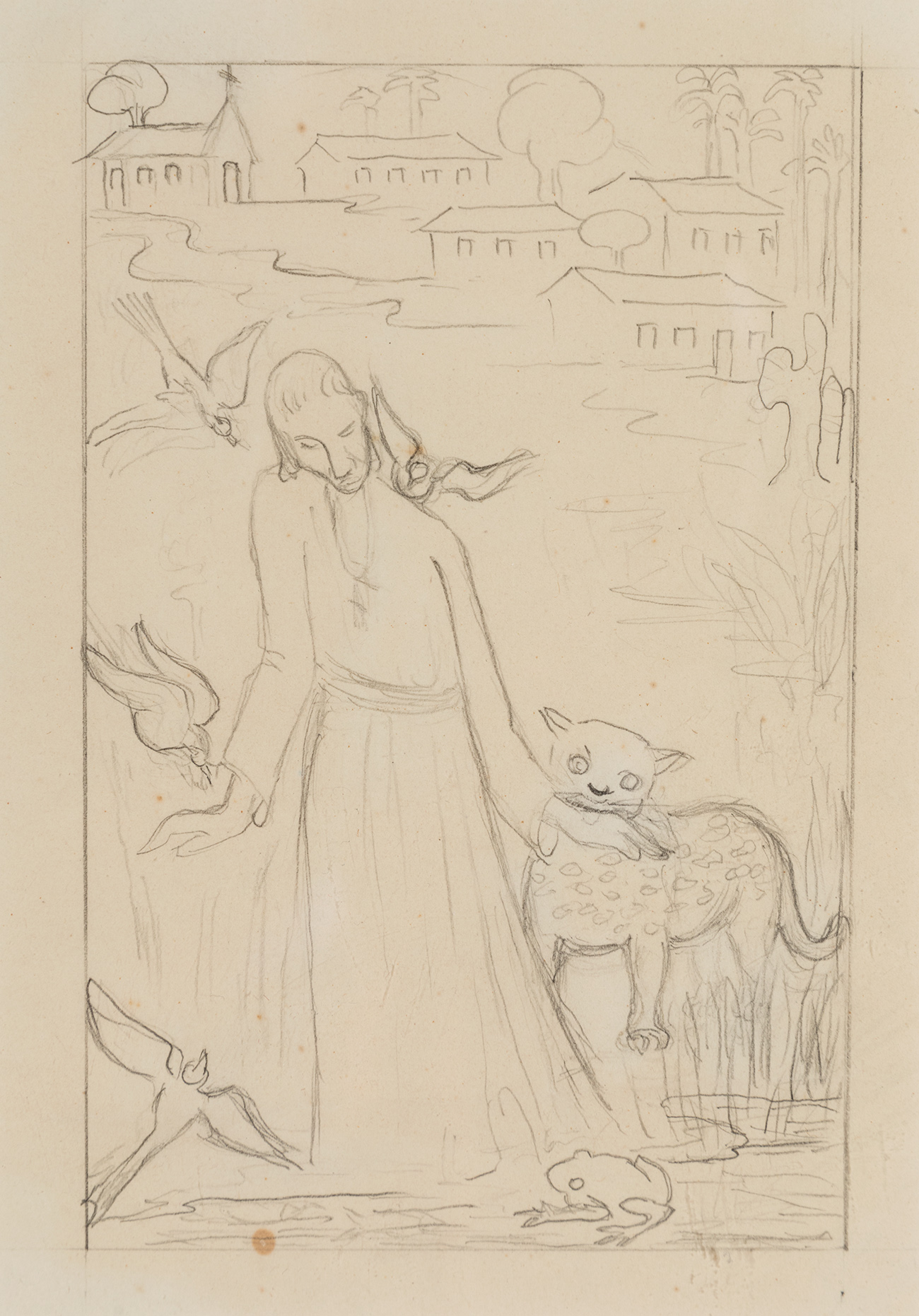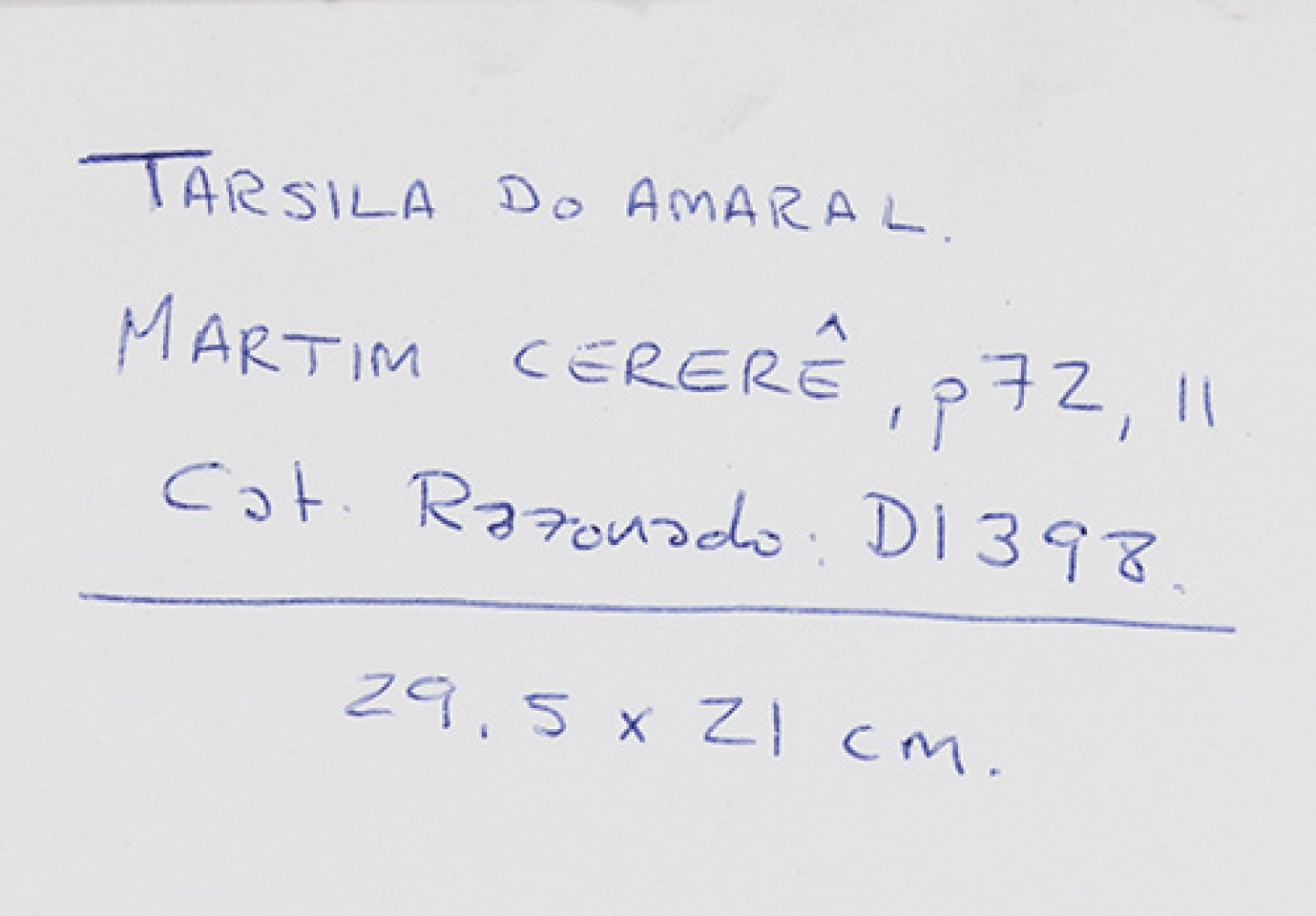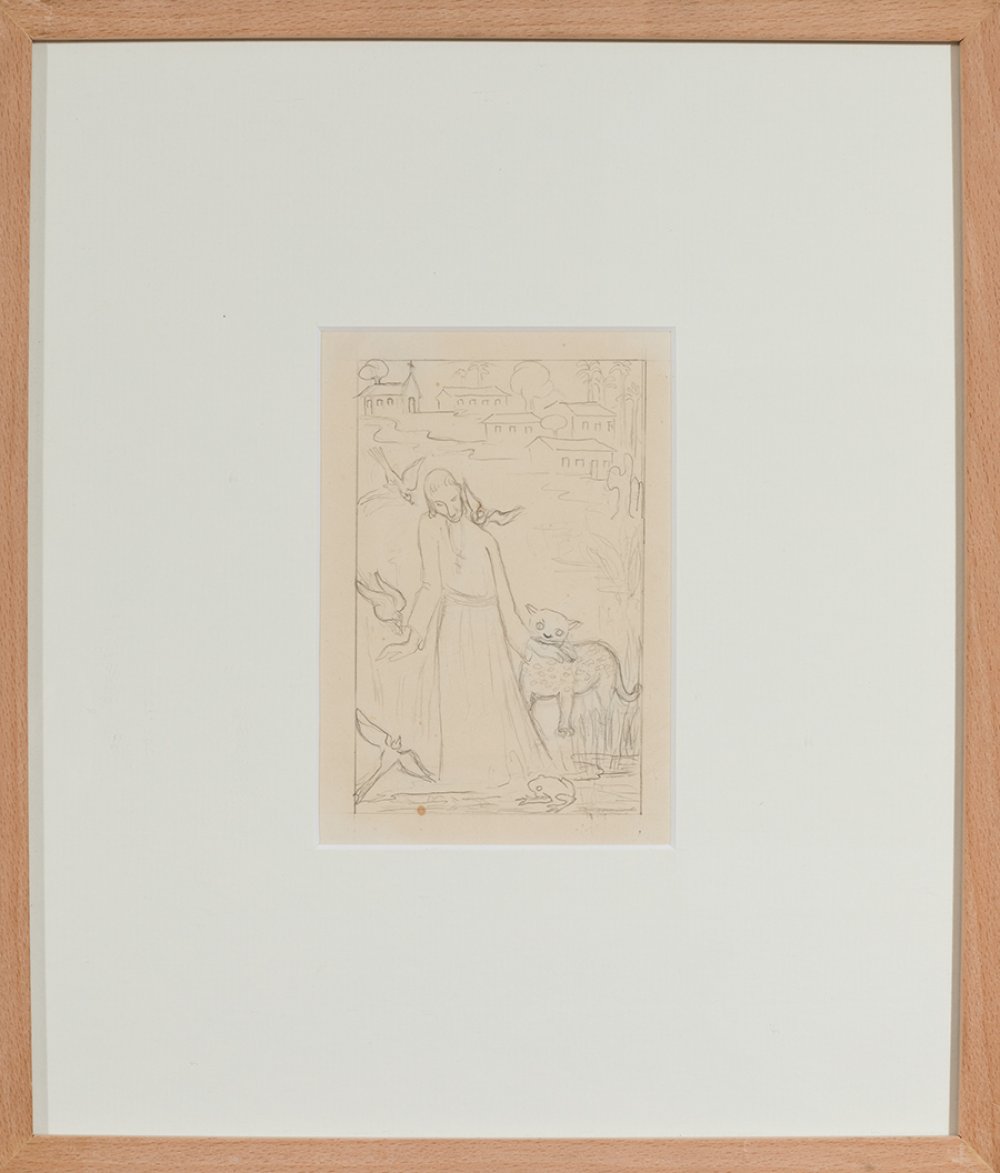7
TARSILA DO AMARAL (Brazil, 1886- 1973)."Illustrated study for the book by Martim Cereré p. 72, II".
"Illustrated study for the book by Martim Cereré p. 72, II".
Pencil on paper.
Work reproduced in the artist's catalogue raisonné. DI398.
Provenance: Luiz Buarque de Hollanda collection.
Size: 29,5 x 21 cm; 39 x 34 cm (frame).
Written in 1928 by Cassiano Ricardo, Martim Cereré is a book of epic poems that delves into the roots of the Brazilian people. In 1962, the artist Tarsila do Amaral rescued the text and created a series of illustrations to accompany the literary publication. This work is the result of that work
Tarsila do Amaral has always been described as the artist who managed on the one hand to capture the European avant-garde and at the same time express her own roots, showing the Brazilian nationalist sentiment in a modern, free and original way. Tarsila began her training in an academic environment, like many of the artists of the time. She studied in Sao Paulo, but in 1920 she moved to Paris to take classes at an academy of classical art. She returned to Brazil in 1922 and found that Sao Paulo was hosting the Semana de Arte Moderno, where she met Anita Malfati and the poet Oswald de Andrade, her future husband. This whole atmosphere had a great influence on her, so much so that she decided to return to Paris in 1922, this time accompanied by Andrade. It was on this second trip to Paris that she began to get to know the European avant-garde. She meets Picasso, but in these years he is married to Olga and in his classical period. Tarsila will have a close relationship with Léger, who changes her aesthetic perspective. He not only brings her closer to the avant-garde, but through the avant-garde she recognises her roots. Through these artists who value the purity of uncontaminated art, other cultures, etc. All this makes him say that he wants to soak up or devour the aesthetic freedom presented to him by European artists in order to come to his country and create an indigenous but modern art, with his feet set on the roots of the country. In April 1923 he returned to Brazil. Shortly before her return, she wrote to her family from Paris: "I feel even more Brazilian. I am going to be a painter of my country; how grateful I am to have spent all my childhood on the farm! The memories of those times have become very dear to me. I want, in art, to be the little country girl from Sao Bernardo, who plays with straw dolls, as in the last painting I am working on... don't think that this tendency is considered negatively here. On the contrary. What they want here is for everyone to bring the contribution of their own country. This explains the success of Russian ballets, Japanese graphic arts and black music. Paris has already had too much Parisian art". She returned to Brazil accompanied by Andrade and the Swiss poet Cendrars, because Cendrars wanted to get to know the real Brazil. They travelled through the popular cultures of Brazil. In the spring of 1924, they visited the Rio carnival with the poet, one of the typical examples of the profane Brazilian festivals, where the races, costumes, traditions, etc. were at their purest. After getting to know this profane festival, they went to see the religious festival of Holy Week in the state of Minas Gerais. From this moment on, Tarsila painted a mixture of local indigenism and the heritage of cubism in her paintings.
"Illustrated study for the book by Martim Cereré p. 72, II".
Pencil on paper.
Work reproduced in the artist's catalogue raisonné. DI398.
Provenance: Luiz Buarque de Hollanda collection.
Size: 29,5 x 21 cm; 39 x 34 cm (frame).
Written in 1928 by Cassiano Ricardo, Martim Cereré is a book of epic poems that delves into the roots of the Brazilian people. In 1962, the artist Tarsila do Amaral rescued the text and created a series of illustrations to accompany the literary publication. This work is the result of that work
Tarsila do Amaral has always been described as the artist who managed on the one hand to capture the European avant-garde and at the same time express her own roots, showing the Brazilian nationalist sentiment in a modern, free and original way. Tarsila began her training in an academic environment, like many of the artists of the time. She studied in Sao Paulo, but in 1920 she moved to Paris to take classes at an academy of classical art. She returned to Brazil in 1922 and found that Sao Paulo was hosting the Semana de Arte Moderno, where she met Anita Malfati and the poet Oswald de Andrade, her future husband. This whole atmosphere had a great influence on her, so much so that she decided to return to Paris in 1922, this time accompanied by Andrade. It was on this second trip to Paris that she began to get to know the European avant-garde. She meets Picasso, but in these years he is married to Olga and in his classical period. Tarsila will have a close relationship with Léger, who changes her aesthetic perspective. He not only brings her closer to the avant-garde, but through the avant-garde she recognises her roots. Through these artists who value the purity of uncontaminated art, other cultures, etc. All this makes him say that he wants to soak up or devour the aesthetic freedom presented to him by European artists in order to come to his country and create an indigenous but modern art, with his feet set on the roots of the country. In April 1923 he returned to Brazil. Shortly before her return, she wrote to her family from Paris: "I feel even more Brazilian. I am going to be a painter of my country; how grateful I am to have spent all my childhood on the farm! The memories of those times have become very dear to me. I want, in art, to be the little country girl from Sao Bernardo, who plays with straw dolls, as in the last painting I am working on... don't think that this tendency is considered negatively here. On the contrary. What they want here is for everyone to bring the contribution of their own country. This explains the success of Russian ballets, Japanese graphic arts and black music. Paris has already had too much Parisian art". She returned to Brazil accompanied by Andrade and the Swiss poet Cendrars, because Cendrars wanted to get to know the real Brazil. They travelled through the popular cultures of Brazil. In the spring of 1924, they visited the Rio carnival with the poet, one of the typical examples of the profane Brazilian festivals, where the races, costumes, traditions, etc. were at their purest. After getting to know this profane festival, they went to see the religious festival of Holy Week in the state of Minas Gerais. From this moment on, Tarsila painted a mixture of local indigenism and the heritage of cubism in her paintings.
22nd September - 19th & 20th Century Art
Sale Date(s)
Venue Address
General delivery information available from the auctioneer
Setdart offers Worldwide shipping
PICK UP IN ROOM: You can come and pick up your lots in our offices (Barcelona, Madrid or Valencia). At the moment of the withdrawal, you will be able to accept the current conditions of the lot by means of a document that you will sign.
YOU CAN SEND ANOTHER PERSON TO PICK UP: This person must present a signed authorization that you can find in our web page by accessing from BUY AT SETDART- LOGISTICS-DOWNLOAD AUTHORIZATION DOCUMENT. You can also send an e-mail with the requested data in AUTHORIZATION DOCUMENT to admin@setdart.com
Important Information
25% buyer´s premium
21% buyer´s premium at www.setdart.com
Terms & Conditions
The maximum period to pay the lots is 7 working days. You can pay either via bank transfer or with credit card through our platform www.setdart.com (we only accept VISA or Mastercard).
BUYER´S PREMIUM: 22% Hammer price + 21% VAT from the buyer´s premium
If your piece has more than 100 years, our Ministry of Culture requires an export certificate in order for the piece to leave the country. Note that if the piece goes inside the EU, there is no cost for the export certificate. If the piece goes outside the EU, there is a cost for the export certificate. You can find more information in our Ministry of Culture website: https://www.culturaydeporte.gob.es/en/cultura/patrimonio/exportacionimportacion/exportacion/tasas.html
INQUIRIES: admin@setdart.com
Setdart guides you through the entire process, from the time of award to the day you receive your lot. Our logistics team will be happy to manage your transport, and will advise you on the best shipping method with professionals from the sector used to handling works of art and jewelry.
WE OFFER WORLDWIDE DOOR TO DOOR SHIPPING
PICK UP IN ROOM: You can come and pick up your lots in our offices. At the moment of the withdrawal, you will be able to accept the current conditions of the lot by means of a document that you will sign.
YOU CAN SEND ANOTHER PERSON TO PICK UP: This person must present a signed authorization that you can find in our web page by accessing from BUY AT SETDART-LOGISTICS-DOWNLOAD AUTHORIZATION DOCUMENT. You can also send an e-mail with the requested data in AUTHORIZATION DOCUMENT to admin@setdart.com
SETDART IS NOT RESPONSIBLE FOR THE STATE OF THE PARTS ONCE THEY LEAVE OUR FACILITIES. MRW SHIPMENTS: Once the payment is made, your lot will be packed for shipment, the logistics department will send you an e-mail notifying you of the day it leaves our warehouse, changes of address cannot be made after receiving this e-mail.
INSURANCE INCIDENTS: Coverage for the value of the auction up to 3000 ? per shipment, if the value of the auction is higher, Setdart will send you a quote including the additional insurance. The insurance company WILL NOT BE RESPONSIBLE FOR THE SHIPMENT THAT EXCEEDS THAT AMOUNT AND IS NOT FULLY INSURED. MRW INCIDENTS: Maximum notification 48 hours after receipt, after which the insurance company WILL NOT BE RESPONSIBLE AND NO CLAIMS WILL BE ACCEPTED.
E-MAIL LOGISTICS: logistica@setdart.com
PICK UP YOUR MESSAGES: You can send your own messaging, prior notice via e-mail that your shipment is ready, please note 3 or 4 days in advance. This type of shipment is packaged so Setdart will provide you with a quote.
EXPENSES FOR STORAGE: We inform you that if the purchased lot is not picked up within a month, you will be charged 30€ per week per lot. Setdart Online S.L., owner of the web site "setdart.com", "setdart.net" and "setdart.org", acts as a company of Spanish nationality inscribed in the Volume 36955, sheet 182, page B-293056 of the Mercantile Registry, with registered office at Calle Aragó









